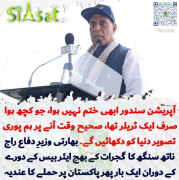RiazHaq
Senator (1k+ posts)
Pakistan's finance minister Ishaq Dar has suggested to his countrymen to eat chicken instead of daal (pulses or legumes). Does the minister sound like Queen Marie-Antoinette (wife of France's King Louis XVI) who reportedly said to hungry rioters during the French Revolution: “Qu'ils mangent de la brioche”—“Let them eat cake”? Let's look into it.
It is indeed true that some varieties of daal are priced higher than chicken. For example, maash is selling at Rs. 260 per kilo, higher than chicken meat at Rs. 200 per kilo. But other daals such as mung, masur and chana are cheaper than chicken.
The reason for higher daal prices and relatively lower chicken prices can be found in the fact that Pakistan's livestock industry, particularly poultry farming, has seen significant growth that the nation's pulse crop harvests have not.
[TABLE="class: tr-caption-container, align: center"]
[TR]
[TD]
 [/TD]
[/TD]
[/TR]
[TR]
[TD="class: tr-caption"]Poultry Farm in Pakistan[/TD]
[/TR]
[/TABLE]
Pakistan's poultry industry achieved 127% growth in the total number of birds produced, 126% growth in the total meat production and 71%growth in terms of total eggs produced between 2000 and 2010, according to government data. As a result, the cheapest sources of animal protein in Pakistan are the eggs and meat from the poultry sector. As of 2013, the per capita availability of poultry meat in Pakistan is 5 kg. In addition, Pakistanis consume 51 eggs per year per capita.
[TABLE="class: tr-caption-container, align: center"]
[TR]
[TD]
 [/TD]
[/TD]
[/TR]
[TR]
[TD="class: tr-caption"]Major Pulse Producing Nations in 2011[/TD]
[/TR]
[/TABLE]
Poultry share of meat consumption in Pakistan has steadily increased over the years. In 1971, the market share of beef was 61%, mutton was 37%, and poultry meat a mere 2-2.5%. In 2010 the market share of poultry meat had increased to 25%, while beef and mutton declined to 55% and 20% respectively. This increase in the overall size of the poultry sector has decreased the gap between the supply and demand of animal proteins and helped stabilize beef and mutton prices, making meat relatively more affordable to more people.
Production of daal, another important source of protein in Pakistan, has not kept pace with demand. Domestic production is not enough to provide 6-7 kilos of daal per person consumed in the country. Pakistan is forced to resort to imports to meet demand. Pakistan spent $139 million to import 628,000 tons of pulses in fiscal year 2010-2011. Pulse imports jumped to $224 million in July 2014 to January 2015 period, according to a report.
Overall, livestock contribution to agriculture in Pakistan has now risen to 58.55 percent, with the rest coming from crops, fisheries and forestry, according to Economic Survey of Pakistan 2015-16. The agriculture sector accounts for 19.82 percent of GDP and 42.3 percent of employment with strong backward and forward linkages. Dairy farming has grown in Pakistan by leaps and bounds, making the country the third largest milk producer in the world.
Services sector now accounts for 59.16% of Pakistan's GDP, the largest sector of the economy, followed by industrial sector that contributes 21.02%. Manufacturing is the most important sub-sector of the industrial sector containing 64.71 percent share in the overall industrial sector.
There has been significant progress in increasing animal protein supply via growth in Pakistan's livestock sector over the last few decades. Nations' policymakers now need to focus on increasing plant protein sources to close the gap between protein supply and demand in an affordable manner.
http://www.riazhaq.com/2016/06/is-chicken-really-more-affordable-than.html
It is indeed true that some varieties of daal are priced higher than chicken. For example, maash is selling at Rs. 260 per kilo, higher than chicken meat at Rs. 200 per kilo. But other daals such as mung, masur and chana are cheaper than chicken.
The reason for higher daal prices and relatively lower chicken prices can be found in the fact that Pakistan's livestock industry, particularly poultry farming, has seen significant growth that the nation's pulse crop harvests have not.
[TABLE="class: tr-caption-container, align: center"]
[TR]
[TD]

[/TR]
[TR]
[TD="class: tr-caption"]Poultry Farm in Pakistan[/TD]
[/TR]
[/TABLE]
Pakistan's poultry industry achieved 127% growth in the total number of birds produced, 126% growth in the total meat production and 71%growth in terms of total eggs produced between 2000 and 2010, according to government data. As a result, the cheapest sources of animal protein in Pakistan are the eggs and meat from the poultry sector. As of 2013, the per capita availability of poultry meat in Pakistan is 5 kg. In addition, Pakistanis consume 51 eggs per year per capita.
[TABLE="class: tr-caption-container, align: center"]
[TR]
[TD]
[/TR]
[TR]
[TD="class: tr-caption"]Major Pulse Producing Nations in 2011[/TD]
[/TR]
[/TABLE]
Poultry share of meat consumption in Pakistan has steadily increased over the years. In 1971, the market share of beef was 61%, mutton was 37%, and poultry meat a mere 2-2.5%. In 2010 the market share of poultry meat had increased to 25%, while beef and mutton declined to 55% and 20% respectively. This increase in the overall size of the poultry sector has decreased the gap between the supply and demand of animal proteins and helped stabilize beef and mutton prices, making meat relatively more affordable to more people.
Production of daal, another important source of protein in Pakistan, has not kept pace with demand. Domestic production is not enough to provide 6-7 kilos of daal per person consumed in the country. Pakistan is forced to resort to imports to meet demand. Pakistan spent $139 million to import 628,000 tons of pulses in fiscal year 2010-2011. Pulse imports jumped to $224 million in July 2014 to January 2015 period, according to a report.
Overall, livestock contribution to agriculture in Pakistan has now risen to 58.55 percent, with the rest coming from crops, fisheries and forestry, according to Economic Survey of Pakistan 2015-16. The agriculture sector accounts for 19.82 percent of GDP and 42.3 percent of employment with strong backward and forward linkages. Dairy farming has grown in Pakistan by leaps and bounds, making the country the third largest milk producer in the world.
Services sector now accounts for 59.16% of Pakistan's GDP, the largest sector of the economy, followed by industrial sector that contributes 21.02%. Manufacturing is the most important sub-sector of the industrial sector containing 64.71 percent share in the overall industrial sector.
There has been significant progress in increasing animal protein supply via growth in Pakistan's livestock sector over the last few decades. Nations' policymakers now need to focus on increasing plant protein sources to close the gap between protein supply and demand in an affordable manner.
http://www.riazhaq.com/2016/06/is-chicken-really-more-affordable-than.html
Last edited by a moderator:
























